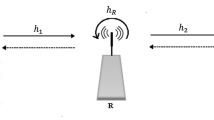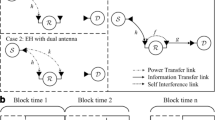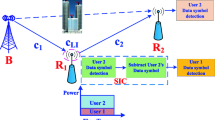Abstract
Energy harvesting (EH) based on ambient radio frequency (RF) has recently become advanced method to prolong the lifetime of the wireless networks. This paper deals with energy harvesting architecture of the full duplex relaying networks. By applying time switching based relaying (TSR) protocol and Amplify-and-Forward (AF) scheme, we derive the closed-form expression of the outage probability and hence compute the optimal throughput. An important result can be seen clearly that the time fraction in TSR impacts on the optimal throughput. Finally, numerical results show an efficient relaying strategy in full duplex cooperative networks.
Access provided by Autonomous University of Puebla. Download conference paper PDF
Similar content being viewed by others
Keywords
1 Introduction
Applications of renewable energy in the next generation wireless networks will be bring huge benefits for continuing operation in mobile equipments. Among other energy sources such as solar and wind power, power extracted from radio-frequency (RF) signals in ambient transmitters can be considered as replacements for traditional wired power grids. Such energy harvest from the natural environment is a promising approach to prolong the lifetime of energy constrained wireless networks such as cellular networks or wireless sensor networks. Simultaneous wireless information and power transfer technology (SWIPT) becomes appealing candidate since it realizes both useful information and energy from RF signals at the same time, and thus potentially offers great convenience to mobile equipments. Varshney first proposed the idea of transmitting information and energy simultaneously in [1]. Using relay to facilitate RF energy harvest and information transfer has also drawn significant attention, which is able to extend the transmission range and increased capacity for system. In [2], the authors studied the throughput performance of an amplify and-forward (AF) relaying system for both time-switching and power-splitting protocols.
More importantly, relaying network is an effective way to combat the performance degradation caused by fading, shadowing, and path loss. Full duplex (FD) relay network has the potential to realize the successful information exchange of two sources and more spectral efficiency than conventional half-duplex (HD) technique. When comparing to the HD mode, the FD mode has higher capacity in practical channel conditions. Alternatively, the FD mode can tolerate high loop interference power while achieving the same capacity as the half-duplex mode. The main disadvantage of FD communication is the self-interference from own node transmission, which is much larger than signal of interest from the distant node. To help the communication node that can transmit and receive signals over the same frequency band, many techniques of suppressing self-interference have been proposed in [3–5]. Unfortunately, the self-interference is residual due to limit technique. The residual interference still decreases the system performance. In fact, [6] indicates that the full-duplex mode is an attractive choice for fixed relays provided that the loop interference power is maintained at a tolerable level. The authors in [7] presented power allocation strategy to maximize the sum-rate of FD-two-way relaying system under realistic residual self-interference.
Recently, a few research trends have been conducted in FD relay system in context of the SWIPT scheme. In [8], the throughputs are analyzed for three relay control schemes, including the maximum relay, optimal relay, and target relay. Analytical expressions for outage probability and ergodic capacity are also presented for these considered relay control schemes. Later in [9], the authors consider two cases depending on the number of antennas used for harvesting and demonstrated that employing both relay antennas for energy harvesting is always beneficial, compared to the HD relaying architecture, results indicate that FD relaying can substantially boost the system throughput. The author in [10] analyzed performance of two-way relaying networks under non-ideal hardware where is linear affected by impairment levels. However, no work related optimal throughput has considered the application of one-way FD relaying in RF energy harvesting systems.
Therefore, in this paper, we analyze the outage probability of full-duplex relaying with novel ability of energy harvesting and information transfer. Based on the analytical expressions, the optimal throughput and energy harvesting time are studied.
The remainder of this paper is organized as follows. Section 2 describes the system model of the EH enabled FD two-way relaying network. Section 3, the outage probability and throughput analysis. Simulation results are presented in Sect. 4. Finally, conclusion of Sect. 5 is drawn in this paper.
2 System Model
Let us consider a wireless dual-hop relay network with AF protocol system illustrated in Fig. 1, in which the destination node can be received at long distance thanks to relay node. The system consisting of three nodes, source node is denoted by \( S \) and destination node is denoted by \( D \) and one relay node \( R \). Each node has two antennas, one of them is responsible for signal transmission and other is responsible for signal reception. The cooperative relay is assumed to be an energy constrained device so that it must harvest energy from the source, and use that energy to amplify and forward the source information to the destination node. We assume that the link between two sources doesn’t exist due to the deep shadowing effect.
The interference cancellation mechanism is adopted to mitigate the self-interference. As the self-interference can not be eliminated completely, certain amount of self-interference remains. The residual self-interference channel at \( R \) is denoted by \( \widetilde{h}_{R} \). Let \( d_{j},\,j = 1,\,2 \) denote the distance between \( S - R \) link and \( R - D \) link respectively and \( h_{j},\,j = 1,\,2 \) denote the channel coefficients between \( S - R \) link and \( R - D \) link respectively.
The scheme used in this investigation is the Time Switching-based Relaying (TSR) protocol as derived in [2]. The main parameters of protocol are expressed in Fig. 2.
Based on the TSR protocol proposed in [2], the communication process is divided into two phases. In the first phase, the energy transfer from the source to the relay with a duration of \( \alpha T,(0 < \alpha < 1) \) and the second phase, the remaining time, \( \left( {1 - \alpha } \right)T \) is used to transmit information, in which \( \alpha \) is time switching coefficient and \( T \) is time for the considered signal frame (Fig. 3).
During the energy harvesting phase, the received signal at the relay as
where \( P_{S} \) is the source transmission power, which is the same in the two sources,\( n_{R} \) is the additive white Gaussian noise at \( R \) with zero-mean and variance of \( \sigma_{n}^{2} \).
Regarding wireless received power, the harvested energy at the relay is given by [2]
where \( m \) is the path loss exponent, \( \eta \) is the energy conversion efficiency, \( h_{1} ,h_{2} \) are the channel coefficients between source-relay link and relay-destination link respectively.
In the information transfer phase, assume that the source node transmits respective signal \( x_{S} \) to \( R \) and \( R \) re-transmits signal \( x_{r} \) to the destination node. \( x_{j} ,\;j = S,R \). They have unit energy and zero–mean, i.e., \( E\left[ {\left| {x_{j} } \right|^{2} } \right] = 1 \) and \( E\left[ {x_{j} } \right] = 0 \). Therefore, the received signal at the relay under self-interference source is rewritten as
where \( \widetilde{h}_{R} \) is the residual self-interference factor at \( R \).
We suppose \( R \) receives \( y_{R} \) and in the next timeslot, \( R \) uses the harvested energy to amplify \( y_{R} \). Hence the magnification of the prior received signal, \( x_{R} \), is
where \( G \) is the amplification factor of \( R \).
Based on AF relaying scheme at \( R \), according to [11] the amplification factor is given by
It is worth noting that harvested power then help operation for the next hop transmission, \( P_{R} \) is given by
where \( \mu \) is defined as \( \mu \triangleq \frac{\alpha \eta }{1 - \alpha } \).
Next, we obtain the received signal at destination as
where \( n_{d} \) is Gaussian noise at destination node.
Substituting (4), (6) into (7), we calculate the received signal as
In the above equations, the instantaneous received SINR at \( S_{j} \) through \( R \) is determined as
By simple replacement, we obtain new formula as
We assume that the channel gains \( \left| {h_{1} } \right|^{2} ,\left| {h_{2} } \right|^{2} \) are independent and identically distributed (i.i.d.) exponential.
3 Outage Probability and Throughput Analysis
In this section, we analyze the outage probability of full-duplex one-way relaying with energy harvesting and information transfer. Based on that analytical expressions, the throughput of scheme is derived and the optimal amount of time for harvesting energy \( \alpha \) is also achieved.
3.1 Outage Probability Analysis
The outage probability of FD relaying network is calculated as
where \( R \) is target rate and \( Z = 2^{R} - 1 \).
Proposition 1
The outage probability of the energy harvesting enabled two way full duplex relay is derived as
where \( \lambda_{s} ,\lambda_{d} ,\lambda_{r} \) are the mean value of the exponential random variables \( h_{1} ,h_{2,} ,\widetilde{h}_{R} \), respectively and \( K_{1} \left( x \right) \) is Bessel function defined as (8.423.1) in [12]
Proof
We denote \( x = \left| {h_{1} } \right|^{2} \left| {h_{2} } \right|^{2} \) and \( y = \left| {\widetilde{h}_{R} } \right|^{2} \) then we have:
Interestingly, the cumulative distribution function of \( x \) is calculated by
and \( y \) can be modeled with probability distribution function \( f_{y} \left( b \right) = \left( {1/\lambda_{r} } \right)e^{{\left( {b/\lambda_{r} } \right)}} \) then the Proposition 1 is achieved after some simple manipulations.
3.2 Optimal Throughput Analysis
In the Proposition 1, the outage probability at the scheme, when the relay harvests energy from the source signal and uses that power to amplify and forward the source signal to the destination is a function of the energy harvesting time α, and exchange when α increase from 0 to 1. In the delay-limited transmission protocol, the transmitter is communicating at a fix transmission rate R bits/s/Hz is and \( \left( {1 - \alpha } \right)T \) is the effective communication time. Therefore, the throughput of system is obtain as
Unfortunately, it is difficult to derive optimal throughput mathematically but we can obtain the optimal value by simulation as presented in the next section.
4 Numerical Results
In this section, we use the derived analytical results to provide the outage probability, optimal throughput, optimal energy harvesting time. We set the source transmission rate \( R = 3,\;4,\;5\;\left( {{\text{bps}}/{\text{Hz}}} \right) \), and hence the outage SINR threshold is given by \( Z = 2^{R} - 1 \). The energy harvesting efficiency is set to be \( \eta = 1 \), the path loss exponent is set to be \( m = 3 \). For simplicity, we set the distance \( d_{1} = d_{2} = 1 \). Also, we set \( \lambda_{s} = \lambda_{d} = 1;\lambda_{r} = 0.1 \).
It can be seen from Fig. 4, the outage probability of different scenarios of time allocation is \( \alpha \). The outage probability is 1 when \( \alpha = 0 \), \( \alpha = 1 \) and so-called the worst performance of the system. The outage is minimum at approximate \( \alpha = 0.75,\;R = 3 \). As we can observe, the analysis curves provide a strictly agreement with simulation curves.
As your observation, Fig. 5 examines the impact of energy harvesting time α on the optimal throughput of systems. The throughput is maximum at approximate \( \alpha = 0.36,\;R = 4 \), and \( \tau \approx 1.45 \) can be called the optimal value. The throughput increases as \( \alpha \) increases from 0 to optimal value \( \alpha \), however it starts decreasing as \( \alpha \) increases over its optimal value. This is because for the values of \( \alpha \) smaller than the optimal \( \alpha \), there is less time for information transmission. Consequently, less time for forward the signal and smaller values of throughput are observed at the destination node due to outage probability increases. On the other hand, for the values of \( \alpha \) greater than the optimal \( \alpha \), more time is wasted on energy harvesting and less time is available for information transmission. As a result, smaller throughput results at the destination node due to smaller value of \( \left( {1 - \alpha } \right) \).
5 Conclusion
In this paper, we have proposed a full duplex relaying network with wireless energy harvesting and information transfer protocol, where an energy constrained relay node harvests energy from the received RF signal and uses that harvested energy to forward the source signal to the other sources. In order to determine the achievable throughput, analytical expressions for the outage probability and the optimal value of energy harvesting time in TSR protocol can be found by simulation.
References
Varshney LR (2008) Transporting information and energy simultaneously. In: Proceedings of IEEE international symposium on information theory (ISIT), pp 1612–1616
Nasir AA, Zhou X, Durrani S, Kennedy R (2013) Relaying protocols for wireless energy harvesting and information processing. IEEE Trans Wireless Commun 12(7):3622–3636
Popovski P, Yomo H (2006) Bi-directional amplification of throughput in a wireless multi-hop network. In: Proceedings of vehicular technology conference, vol 2. Melbourne, Australia, May 7–10, pp 588–593
Louie RH, Li Y, Vucetic B (2010) Practical physical layer network coding for two-way relay channels: performance analysis and comparison. IEEE Trans Wireless Commun 9(2):764–777
Rankov B, Wittneben A (2006) Achievable rate regions for the two-way relay channel. In: Proceedings of IEEE international symposium on information theory. Seattle, WA, USA, pp 1668–1672
Riihonen T, Werner S, Wichman R (2009) Comparison of full-duplex and half-duplex modes with a fixed amplify-and-forward relay. In: IEEE 2009 IEEE wireless communications and networking conference. Budapest, Hungary
Yang J, Liu X, Yang Q (2014) Power allocation of two-way full-duplex AF relay under residual self-interference. In: IEEE 2014 14th international symposium on communications and information technologies (ISCIT). Incheon, South Korea
Zhong C, Suraweera HA, Zheng G, Krikidis I (2014) Relay control for full-duplex relaying with wireless information and energy transfer. IEEE Trans Commun 62(10)
Zhong C, Suraweera HA, Zheng G, Krikidis I (2014) Wireless information and power transfer with full duplex relaying. IEEE Trans Commun 62(10)
Do D-T (2015) Power switching protocol for two-way relaying network under hardware impairments. Radio Eng J 24(3)
Kwon T, Lim S, Choi V, Hong D (2010) Optimal duplex mode for DF relay in terms of the outage probability. IEEE Trans Veh Technol 59(7):3628–3634
David HA (1970) Order statistics. Wiley, New York
Author information
Authors and Affiliations
Corresponding author
Editor information
Editors and Affiliations
Rights and permissions
Copyright information
© 2016 Springer International Publishing Switzerland
About this paper
Cite this paper
Kieu, T.N., Do, DT., Xuan, X.N., Nhat, T.N., Duy, H.H. (2016). Wireless Information and Power Transfer for Full Duplex Relaying Networks: Performance Analysis. In: Duy, V., Dao, T., Zelinka, I., Choi, HS., Chadli, M. (eds) AETA 2015: Recent Advances in Electrical Engineering and Related Sciences. Lecture Notes in Electrical Engineering, vol 371. Springer, Cham. https://doi.org/10.1007/978-3-319-27247-4_5
Download citation
DOI: https://doi.org/10.1007/978-3-319-27247-4_5
Published:
Publisher Name: Springer, Cham
Print ISBN: 978-3-319-27245-0
Online ISBN: 978-3-319-27247-4
eBook Packages: EngineeringEngineering (R0)









